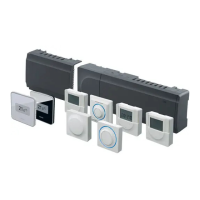A connection example of Uponor Smatrix Base/Base
PRO Controller (six channels) with an optional Uponor
Smatrix Base Slave Module (six extra channels) using
system devices (S) and thermostats (T) as shown in
figure.
The installation will work in a standard way with the
thermostats regulating each room according to their set
temperatures.
Connections
The system is based on a bus communications protocol
(requires the thermostats unique ID to be registered
to the controller), utilising daisy chain, direct or
star topology connections. This allows serial and
parallel connections, making wiring and connection
of thermostats and system devices much easier than
connecting one thermostat per connection terminal.
The wide array of connection possibilities presented
with this communications protocol can be combined in
any way best suited for the current system.
Thermostats and actuators
• Thermostat #01 controls the actuators on channels
01a, 01b, 02a and 02b with the help of an option.
• Thermostat #03 controls the actuators on channels
03 to 05 with the help of an option.
• Thermostat #06 controls the actuators on channels
06 and 07.
• Thermostat #08 controls the actuators on channels
08 to 11 with the help of an option.
• Thermostat #12 controls the actuator on channel
12.
System devices
• Interface I-147 (Base PRO only) controls the whole
system and individual settings for each thermostat
can be set. Schedules can be programmed for one
or several thermostats instructing them when to
switch between Comfort and ECO modes.
• The timer (Base only) controls the switching
between Comfort and ECO modes for all available
thermostats activated for scheduling (except the
digital thermostat T-148).
• Public thermostat T-143 with various functions
(options B and C).
NOTE!
If registering a public thermostat T-143 with
various functions as a system device, the
thermostat only acts as a remote unit. It does
not control the room temperature in the room
where it is placed.
Option A
• External temperature sensor.
• Floor temperature sensor.
Option B
• Outdoor temperature sensor.
Option C
• External temperature sensor for heating/cooling
switch (Base PRO with interface only).
• Comfort/ECO mode switch.

